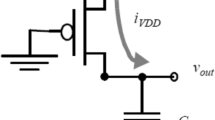Abstract
In this paper, two techniques to reduce the energy and the average power consumption of the system are proposed. They are based on the fact that as the test progresses, the detection efficiency of the pseudo-random vectors decreases very quickly. Many of the pseudo-random vectors will not detect faults in spite of consuming a significant amount of energy from the power supply. In order to prevent this energy consumption, a filtering of the non-detecting vectors and a reseeding strategy are proposed.
These techniques are evaluated on the set of ISCAS-85 benchmark circuits. Extensive simulations have been made using the SAIL energy simulator showing that, in large circuits, the energy consumption and the average power savings reach 90.0% with a mean value of 74.2% with the filtering technique, and 97.2% with an average value of 90.9% with the reseeding strategy.
Similar content being viewed by others
References
W.H. Debany, “Quiescent Scan Design For Testing Digital Logic Circuits,” Proc. Dual-Use Tech. & App., May1994, pp. 142-151.
Y. Zorian, “A Distributed BIST Control Scheme for Complex VLSI Devices,” VLSI Test Symp., April 1993, pp. 4-9.
R.M. Chou, K.K. Saluja, and V.D. Agrawal, “Power Constraint Scheduling of Tests,” Proc. 7th International Conf. VLSI Des., Jan. 1994, pp. 271-274.
H. Cheung and S.K. Gupta, “A Bist Methodology for Comprehensive Testing of RAM with Reduced Heat Dissipation,” Int. Test Conf., Oct. 1996, pp. 386-395.
S. Wang and S.K. Gupta, “DS-LFSR: A New BIST TPG for Low Heat Dissipation,” Int. Test Conf., Oct. 1997, pp. 848-857.
Al Hertwig and H.-J. Wunderlich, “Low Power Serial Built-In Self-Test,” Eur. Test Work, May 1998, pp. 49-53.
X. Zhang, K. Roy, and S. Bawmik, “POWERTEST: A Tool for Energy Conscious Weighted Random Pattern Testing,” Proc. 12th International Conf. VLSI Design, Jan. 1999, pp. 416-422.
P. Girard, L. Guiller, C. Landrault, and S. Pravossoudovitch, “A Test Vector Inhibiting Technique for LowEnergy BIST Design,” VLSI Test Sym., April 1999, pp. 407-412.
S. Hellebrand, S. Tarnick, J. Rajski, and B. Courtois, “Generation of Vector Patterns Through Reseeding of Multiple-Polynomial Linear Feedback Shift Register,” Proc. Int. Test Conf., Oct. 1992, pp. 120-129.
P. Girard, L. Guiller, J. Figueras, S. Manich, P. Teixeira, and M. Santos, “Low Power Pseudo-random BIST: On Selecting the LFSR Seed,” Dis. Cir. Int. Sist., Nov. 1998, pp. 166-172.
W. Nebel and J. Mermet, “Low Power Design in Deep Submicron Electronics,” NATO ASI Series, Vol. 337, Kluwer, 1996.
S. Manich and J. Figueras, “Sensitivity of the Worst Case Dynamic Power Estimation on Delay and Filtering Models,” Pow. Tim. Mod. Opt. Sim., Sept. 1997, pp. 141-150.
E.M. Sentovich, K.J. Singh, L. Lavagno, C. Moon, R. Murgai, A. Saldanha, H. Savoj, P.R. Stephan, R.K. Brayton, and A.S.-Vincentelli, “SIS: A System for Sequential Circuit Synthesis,” Elec. Res. Lab. Memo. UCB/ERL M92/41, May 1992.
Author information
Authors and Affiliations
Rights and permissions
About this article
Cite this article
Manich, S., Gabarró, A., Lopez, M. et al. Low Power BIST by Filtering Non-Detecting Vectors. Journal of Electronic Testing 16, 193–202 (2000). https://doi.org/10.1023/A:1008331029249
Issue Date:
DOI: https://doi.org/10.1023/A:1008331029249




